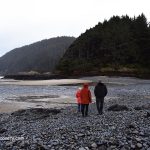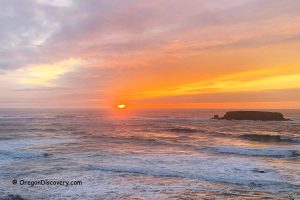
Tidepool watching is one of the most popular pastime on the Oregon Coast. Many rocky beaches feature amazing tidepools, which are not dissimilar to a kaleidoscope. Every receding tide leaves a new and unique colorful assembly of marine animals and plants that will never be repeated again.
Along the rugged Pacific coastline, surging waves and tides create an ecosystem teeming with oxygen and nutrients. Within this dynamic environment, a diverse community of marine creatures has adapted to thrive amidst constant change.
Oregon Coast Tide Pool Animals
California Mussel generates silky threads to anchor themselves to rocks while being battered by relentless waves in the mid-tide zone. They eat plankton filtered from the water.

Sea Anemone is a predatory marine invertebrate. This colorful creature opens itself to grab and paralyzes its prey with its stinging tentacles. Closed anemone looks like a donut.

Sea urchins is spherical and covered with spines. They hides its mouth beneath the body. Its spines capture bits of food, and specialized tube feet transport the food to its mouth.

Purple or Ochre Sea Star has five stout rays and its color can be purple, orange, yellow, red, and brown. This species has a capacity to release up to 40 million eggs. After hatching, the tiny larvae drift in the water for several months before maturing sea stars eventually settle on the seafloor to feed on mussels, barnacles, snails, and limpets.

Gumboot Chiton, also known as the Giant Pacific Chiton, is a type of mollusk characterized by its unique feature of having eight armored plates concealed beneath its skin. These intriguing creatures exhibit remarkable longevity, with some individuals living for more than four decades. They can attain a size of up to 14 inches (36 cm) and can weigh over 4 pounds (2 kilograms)".

What is the Best Time to See Tide Pools?
High tides bring parts of the oceanic flora and fauna into the coastal pockets and pools; low tides then reveal those snapshots of underwater living to the human eye. This means you will have to time your tidepool watching to the time when the tide is low.
The ideal time would be an hour or so before the tide recedes to its lowest point. A tide chart would be the best way to plan it.
The coast’s rule of thumb is two low and two high tides daily. The peak tides (both high and low) are spaced by about six hours between each other.

Technically (and scientifically), unlike the regular (solar) day measured by a full rotation of a specific point on Earth under the Sun, a lunar day is measured by a full rotation of a specific point under the Moon. This makes a lunar day 50 minutes longer, as that measurement point on Earth has to catch up to the Moon, which rotates around the Earth and kind of “runs away” from that measurement point.
The 24-hour and 50-minute lunar day is close enough to the 24-hour solar day. However, the 50-minute difference accumulates quickly, increasing your chances of missing the optimal tidepool-watching experience. Tide charts are, therefore, your go-to tool.
While you will have to do your own tide-timing homework with the charts, we have you covered concerning the best tidepools to check out across the entire Oregon shoreline.

Tidepools Safety

Exposed rocks in the intertidal zone can be dangerously slippery, especially if covered with seaweeds. Wear proper shoes with good traction, like hiking boots and aquatic shoes.
Water sandals are an acceptable choice, but it is better to have some toe protection since you can still slip on a rock and hit your foot.
Pay attention to what you step on and stick to sand, gravel, and rocks clear of greenery. Many rocks are covered with mussels, barnacles, and other oceanside creatures. Avoid walking on those for safety and to preserve fragile ecosystems.
It is a good idea to have trekking poles with you for additional traction and to help keep your balance. Those are also great since you can anchor yourself during a tide surge or a sneaker wave.
Summer is the safest time to do tidepool watching. If you visit tidepools during winter, pay very close attention to the weather conditions and the ocean behavior.
Winter storms create additional risks with wave surges, surf condition changes, sneaker waves, rapid tide rises, and storm-enhanced tidal currents.
If you bring children or dogs with you, pay special attention to them and where they are going.
Life jackets for kids and dogs are cheap and lightweight and can mean the difference between life and death if a tide suddenly surges or a sneaker wave arrives.

Tide Pool Etiquette
Tide-pool inhabitants display remarkable resilience in their challenging habitat, yet they remain highly susceptible to human impact. Please adhere to the following tide-pool guidelines to ensure the survival of our intertidal creature companions during your visit:
Tread with Care: Walk thoughtfully, making every effort to avoid stepping on marine animals or plants.
Observe sea animals and shells where they are: When interacting with intertidal animals, exercise extreme care. Never remove animals and shells, as poking, pulling, or prying them can cause harm or even death. Leave tridepools undisturbed - do not turn over or throw rocks as this can hurt these fascinating critters.
Enjoy exploring fascinating intertidal areas - Capture Memories and Collect Photographs only.
The Best Oregon Coast Tidepool Watching Beaches
For the folks with significant time constraints, we have picked the best of the best in each part of the coast (north, central, and south).
North Oregon Coast
Cannon Beach is listed as one of the 100 most beautiful beaches in the world. On the low tide, you can walk to Haystack Rock and the Marine Garden to explore exposed marine life - mussels, barnacles, and sponges on rocks and sea anemones, crabs, sea slugs, and starfish in the tidepools.
The rocks near both headlands surrounding Indian Beach are fantastic places to see many ocean creatures in low and minus tides. You can observe saltwater flora and fauna, including anemones, sea stars, crabs, and much more!
Arcadia Beach is a fantastic place for oceanside adventures, including tidepool watching. On a low tide, you can see a beautiful image of ocean flora and fauna in the pools by the rocks.
At Short Sand Beach, you can enjoy a variety of adventures in beautiful scenery. You can witness a stunning display of ocean life trapped in the tidepools during low tide.
On a low tide, Hug Point Beach is a fantastic tidepool-watching location. In the pools, you can enjoy colorful pictures of anemones, crabs, starfish, and other ocean creatures.
Tunnel Beaches are known for their scenic interdial area. During low tides, visitors can explore the rich marine life, including colonies of mussels, anemones, and sea stars.
At low tide, visitors can enjoy tidepooling near the rocks and sea stacks, discovering vibrant marine creatures like sea anemones and starfish.
Central Oregon Coast
Cobble Beach is one of the richest tidepool spots on the Oregon Coast. Tidepools here are numerous and show a colorful kaleidoscope of marine life, including purple sea stars, green anemones, purple sea urchins, tidepool sculpins, hermit crabs, and more!
Fogarty Creek is a one-spot place for many outdoor adventures, including tidepool watching. On a low and minus tide, you can see a colorful kaleidoscope of marine life, including sea stars, anemones, sea urchins, and tidepool sculpins.
During low tides at Seal Rock Beach, bedrock outcroppings are exposed so you can explore its intertidal zone with numerous amazing marine creatures in tidepools.
 Smelt Sands State Recreation Site
Smelt Sands State Recreation Site
As the tide recedes, it reveals tidepools bustling with colorful sea anemones, crabs, starfish, and other ocean creatures.
The intertidal zone at the park is full of marine creatures including sea anemones, crabs, starfish, purple sea urchin, and California mussel.
Strawberry Hill Wayside is known for its gorgeous tide pools full of anemones, sea stars, and other sea creatures.
Low and minus tides at Stonefield Beach reveal a beautiful picture of tidepool creatures, including sea stars, anemones, sea urchins, and more.
Neptune Beach is a scenic location with beautiful tidepools full of ocean creatures. Here, you can see sea stars, sea urchins, anemones, tidepool sculpins, and other saltwater flora and fauna.
When the tide is low at Hobbit Beach, you can walk farther toward the edge of the Heceta Head. Here, you can see tide pool creatures and oceanic vegetation sitting between rocks with sea birds walking around.
South Oregon Coast
In addition to the historical significance, Battle Rock Wayside Park intertidal area is the best tidepool-watching spot on the southern Oregon coast. You can see many colorful marine creatures here, including sea stars, anemones, sea urchins, and gumboot chiton.
 Paradise Point State Recreation Site
Paradise Point State Recreation Site
Paradise Point State Recreation Site with Garrison Beach is excellent for surfing, beachcombing, rockhounding, and tidepool watching. On the low tide, you can see colorful sea creatures in the rocky area of the beach.
On Arizona Beach, you can see a magnificent image of sea stars and other marine creatures at low tide. Red, purple, orange, shades of green, and other colors create a beautiful picture every time the ocean briefly exposes its flora and fauna.
Bailey Beach is a hidden gem of the Pacific Northwest with many adventures to have, including tidepool watching. Low tide creates scenic pools near the rocks and on the beach.
Low tides at Lone Ranch Beach reveal a beautiful kaleidoscope of sea creatures and plants in the tidepools near Cape Ferrello.
 McVay Rock State Recreation Site
McVay Rock State Recreation Site
The McVay rocky shore creates a fantastic environment for tidepool watching. You can see various marine life, including starfish, anemones, urchins, crabs, and more. Please be careful around tidepools and don't disturb or step on ocean flora and fauna.
Caution:
- Wear good shoes to avoid falling off the slippery rocks (flip-flops are not good shoes. Don't tell me I haven't warned you).
- Pay attention to your surroundings and never turn your back to the ocean since sneaker waves can come unexpectedly.
- Don't touch ocean life. Tidepool creatures are part of a fragile ecosystem already weakened by human activity. There's no need to make it worse.
You May Also Like
Attention, Fellow Beachgoers!
Unfortunately, our beautiful Pacific Northwest beaches are stained with trash, especially plastic. We at Oregon Discovery, as well as other unaffiliated groups of nature lovers, made a commitment to do our part in keeping our beaches clean, but we need your help too!
Whenever you go out to enjoy nature at your favorite spot, please bring a trash bag or two and help us pick up garbage. Even picking up a little bit here and there will make a huge long-term difference.
Please, help us save our beautiful nature for generations to come!



























